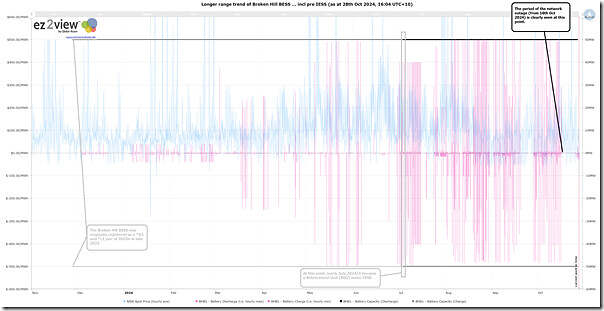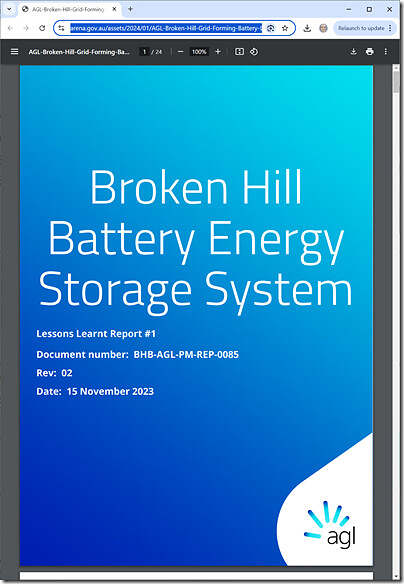We noted this morning that ‘Broken Hill BESS discharges into the Sunday evening peak (27th October 2024)’.
Curiosity, and external questions, prompted me to have a longer-range look at operations – via the ‘Trends Engine’ in ez2view – this afternoon as follows:
With respect to the above, the following are some key dates:
| Date | Details |
|---|---|
4th September 2021 |
According to this project page at ARENA, this date was the project start date for the AGL Broken Hill Grid Forming Battery. |
25th March 2022 |
ARENA published this news update ‘Testing grid forming capabilities with AGL’s Broken Hill Battery’ which noted: ‘On behalf of the Australian Government, the Australian Renewable Energy Agency (ARENA) has today announced $14.84 million in funding to AGL to build a 50 MW / 50 MWh lithium-ion large scale battery storage system with grid forming capabilities at Broken Hill, New South Wales.’ … and, at the bottom of this release, it notes: ‘AGL’s Broken Hill Battery is set to be completed in 2023.’
On the same day, AGL Energy published the Media Release ‘AGL and ARENA lock-in Broken Hill battery’, which noted: ‘AGL has today announced a final investment decision (FID) of $41 million with the Australian Renewable Energy Agency (ARENA) for its Broken Hill battery. The 50 megawatt (MW), 50 megawatt hour (MWh) battery will be supplied by Fluence and its consortium partner Valmec. |
|
10th Nov 2022 |
AGL Energy released the Media Release ‘Breaking ground at Broken Hill for AGL’s new grid-scale battery’ on 10th November 2022, which noted: ‘The 50-megawatt (MW), 50-megawatt hour (MWh) lithium-ion battery will be operational in mid-2023, providing the Broken Hill community with greater energy stability.’
|
(several dates in)
|
The 15th November 2023 was the date on the cover of this ‘Lessons Learnt Report #1 (Revision 2)’ … though I note that the date at the footer of the document itself says October 2023 (so perhaps that was for revision 1?): In the trend chart above, we can see that the 27th November 2023 is the date at which the battery was first registered in the AEMO’s EMMS (though still to provide any output). It isn’t until 3rd December 2023 that we start to see initial slivers of output. |
15th March 2024 |
On 15th March 2024, Dan Lee wrote ‘Need for speed: How long has each battery project in the NEM taken to deliver?’ … and, in this article: 1) classified operations at the time for the Broken Hill BESS as ‘partial’. … at that point, we can see in the chart above regular bursts of charge and discharge at about half of the 50MW Maximum Capacity. 2) noted the delivery had taken over 2 years since a Financial Close of March 2022 … with the project first announced in December 2021. |
|
mid May 2024 |
We can see, in the chart above, that it’s not till the middle of May 2024 that charge and discharge approaches 100% of Maximum Capacity. |
early July 2024 |
The main phase of the IESS rule change process commenced on 3rd June 2024, but it was not until later that the Broken Hill BESS transitioned: 1) From the pair of units BHBL1 and BHBG1; 2) To the bi-directional unit BHB1. The date at which the new DUID was registered was 3rd July 2024, but it did not cut over until 17th July 2024. |
Towers Down… from 16th October 2024 |
It was overnight Wednesday 16th October 2024 that we saw ‘Seven transmission towers collapse near Broken Hill overnight’. Following from that, we have collated a number of articles about the situation here on WattClarity. — Others have also been following what’s happening… 1) In particular, it’s worth noting these (a) on Friday 25th October ‘Broken Hill has a wind farm, a solar farm and a big battery. So, why are the lights out?’. (b) on Saturday 26th October ‘Agreement finally reached to switch on Broken Hill battery, nearly 10 days after storm blows down power lines’; and (c) On Sunday 27th October, ‘Broken Hill battery charges up to create local micro-grid, but why was it disabled in the first place’. (d) belatedly adding in the article from Monday 28th October about ‘Energy regulator joins probe into reasons for lengthy blackouts in storm-hit Broken Hill’. 2) But, of course, there are others who are also following and reporting.
|
Operating in an island… from 26th October 2024 |
After ~10 days of no operations, we noted: 1) Firstly ‘Broken Hill BESS restarts operations (cautiously), on Saturday 26th October 2024’ 2) And then this morning ‘Broken Hill BESS discharges into the Sunday evening peak (27th October 2024)’
|
As time permits, we’ll keep an eye on what’s happening around Broken Hill (including with respect to the battery) …




Might be helpful if people read the “Lessons Learned” document prior to pounding keyboards. Appears the project was all about studying the stabilising potential of a grid forming BESS in a fringe of grid radial system with relatively high renewable energy (inverter connected) inputs – hence ARENAs involvement as a research project. It was not about keeping the lights on. This is entirely consistent with what would otherwise be a somewhat odd combination of a 50MW inverter and 50MWhr battery (ie one hour of storage at rating). Indeed, I would be surprised if without major re-engineering of protection systems in the town it would be possible to run on the grid forming battery and renewable energy sources because of a very low faut level. Once a synchronous generator (or generators) were running it is possible provided the dynamic response of the power electronics does not end up pushing the generator off. Hence why things are being taken very gently. Sounds like sensible and prudent engineering practice to me. Not a great situation for anybody, but it appears the battery was never designed to keep the lights on, despite what the media people might have written. The best it might do is accept the risk of fault level issues whilst the GTs ran up and synchronised following a line trip – say 10 minutes.